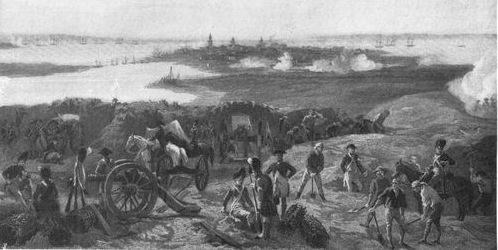 |
Patriot Resource Index
 American Revolution Index
American Revolution Index
 Surveys and Lists
Surveys and Lists
Military Campaigns
-:Saratoga Campaign
-:Southern Campaign:
Part I
Part II
Timeline
Department Cmdrs
-:West Florida Campaign
-:Yorktown Campaign
Reference Lists
Surveys By Year
 American Revolution Index
American Revolution Index
 Battles
Battles
 Documents
Documents
 Events
Events
 Landmarks & Places
Landmarks & Places
 People: The Patriots
People: The Patriots
 People: Continental Army
People: Continental Army
 People: British Army
People: British Army
 Timelines
Timelines
 Books
Books
 Multimedia
Multimedia
 Links & Other Resources
Links & Other Resources
Search the Site
Site Map
Contact Us
PatriotResource.com:
Main Index
Film Index
Film: Gladiator
Film: National Treasure
Film: The Patriot
Film: Tombstone
Films: General
Films: Fantasy
Films: SciFi
History: 1775-1781
History: September 11th
Lord of the Rings
NORAM Road Trips
OtherWorld: Index
TV Series: Index
TV: Battlestar Galactica
TV: Caprica
TV: Deadliest Catch
TV: Lost
TV Series: Action
TV Series: Animated
TV: BBC Presentations
TV Series: Comedy
TV Series: Drama
TV: Fantasy/SciFi
TV Series: Western
TV Series: Reviews
Military Campaigns
-:Saratoga Campaign
-:Southern Campaign:
Part I
Part II
Timeline
Department Cmdrs
-:West Florida Campaign
-:Yorktown Campaign
Reference Lists
Surveys By Year
Site Map
Contact Us
Main Index
Film Index
Film: Gladiator
Film: National Treasure
Film: The Patriot
Film: Tombstone
Films: General
Films: Fantasy
Films: SciFi
History: 1775-1781
History: September 11th
Lord of the Rings
NORAM Road Trips
OtherWorld: Index
TV Series: Index
TV: Battlestar Galactica
TV: Caprica
TV: Deadliest Catch
TV: Lost
TV Series: Action
TV Series: Animated
TV: BBC Presentations
TV Series: Comedy
TV Series: Drama
TV: Fantasy/SciFi
TV Series: Western
TV Series: Reviews

Lt. Colonel Banastre Tarleton helped seal Charleston's fate by defeating Colonel Isaac Huger at the Battle of Monck's Corner on April 14, 1780. Charleston held out almost a month more, but finally was surrendered by Maj. General Benjamin Lincoln to Lt. General Henry Clinton on May 12, 1780. General Clinton ordered Lt. General Charles Earl Cornwallis into the back country to secure outposts and put down any possible remaining resistance. On June 4, 1780, General Clinton sailed back north to New York to deal with General George Washington, leaving General Cornwallis in command of the Southern Theatre. His only orders to Cornwallis was that he maintain control of the ports of Charleston and Savannah, Georgia. Cornwallis had little resistance at first since now the closest organized Continental force was camped in North Carolina awaiting a replacement commander for Maj. General Lincoln.
General Cornwallis felt that the best way to do this was to move northward, sweeping through the countryside of South Carolina into North Carolina and finally meeting General Clinton in Virginia. It was hoped that this strategy would draw Tories/Loyalists to the British banner as garrisons and supply lines were established. Cornwallis planned to use Major Patrick Ferguson's Tory corps to protect his left flank by sending Ferguson into the westernmost regions and Lt. Colonel Tarleton's Green Dragoon cavalry to scout ahead and act as a mobile extension of the main army.
One of the first engagements of this campaign took place on May 29, 1780, at the Battle of Waxhaws, when Lt. Colonel Tarleton caught up with a retreating force of Continental regulars under Colonel Abraham Buford at Waxhaws. The controversial battle became known as Buford's Massacre and established Tarleton's reputation as giving no quarter. Cornwallis also attempted to protect and support Tories in the backcountry by establishing a series of garrisons. However, during the summer of 1780, Tories were involved in vicious skirmishing with bands of Patriot militia, especially an organized force under Thomas Sumter.
General Cornwallis was successful with his strategy as he moved through South Carolina. In July, Maj. General Horatio Gates arrived as the new Southern Commander and moved to take the crossroads location of Camden. On August 16, 1780, Cornwallis soundly defeated Gates at the Battle of Camden, South Carolina, when two-almost all the militia, who made up nearly two-thirds of his force, fled without firing a shot. The following day, Lt. Colonel Tarleton surprised Thomas Sumter and his militia, who had been raiding British supply lines, at Fishing Creek on the Wateree River. Sumter escaped, but his militia was scattered. These successive victories left no organized resistance in South Carolina. General Cornwallis next moved into North Carolina, leaving Tories in charge of his newly established garrisons in South Carolina. On September 26, 1780, Charlotte, North Carolina was occupied by Cornwallis.
However, the backcountry was proving harder to tame than expected. Even though Thomas Sumter was still reorganizing his militia, Francis Marion and others were proving to be very troublesome in the backcountry. As a result, on September 2, General Cornwallis had sent Major Ferguson out to recruit more Tories and give a strong British presence in the western regions of the Carolinas. He and his Tory force skirmished with militia colonels Elijah Clarke and Isaac Shelby. Ferguson made the mistake of sending threats into the mountain country, where the men had been content to mostly sit out the war.
Available at Amazon.com:

The Road to
Guilford Courthouse
by John Buchanan
